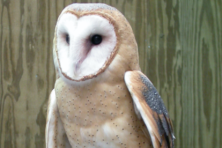An Irruption of Snowy Owls
- Share
- Tweet
- Pin
- Share

Observing a snowy owl in the wild can be a thrilling experience, and early reports statewide indicate birders and non-birders alike may be afforded more viewing opportunities this winter.
As their name suggests, snowy owls are generally a northern species, nesting worldwide on the treeless tundra above the Arctic Circle. During a typical winter, some remain close to their breeding areas, while others head south into southern Canada and the northern United States, including a small number in Wisconsin each year.
Every handful of years, however, large numbers move into Wisconsin in an event known as an irruption. Why these irruptions occur is not completely understood, but is thought to be closely tied to snowy owls’ favorite tundra prey – small rodents known as lemmings.
Surprisingly, this year marks the third consecutive year, and fourth out of the last five, with an irruption of snowy owls in Wisconsin. As of Nov. 9, approximately 72 snowy owls have been recorded in 37 counties across the state. This compares to only five owls by this date in 2014, while no owls arrived until Nov. 15 in 2013. This year’s birds first arrived Oct. 15, nearly a month earlier than most years.
“It’s extremely unusual to see irruptions into the same region in three straight years,” said Ryan Brady, a Wisconsin Department of Natural Resources research scientist. “But, this is a mysterious species whose movements and ecology we do not fully understand, largely because of the remote northern haunts it typically calls home.”
To help those interested in learning more about snowy owls, the department has created a new webpage with helpful information, including periodic species updates and viewing tips.
For more information regarding snowy owls in Wisconsin, search keywords “snowy owls.”
People can improve their chances of viewing a snowy owl in the wild by understanding the species’ habits. Check low-level perches in open, tundra-like habitats around dawn or dusk from November to March. Common habitats include coastal beaches and harbors, open grasslands and agricultural fields, wetland complexes, airports, and vast expanses of ice-covered water bodies.
Snowy owls are not averse to civilization, and can also be found in suburban or urban settings. In these habitats snowy owls eat a wide variety of prey from small rodents to rabbits to ducks and other birds. They can be seen any time of day, though many individuals only roost during daylight hours and actively hunt from dusk to dawn.
Brady asks owl observers to report their sighting to Wisconsin eBird at ebird.org/wi, an online bird reporting system that helps track snowy owls and other bird species.
Viewing considerations
Some general recommendations for observing snowy owls in the wild include:
- Do not approach an owl too closely. You are too close if the bird frequently looks at you, sits erect with open eyes peering in your direction, or flushes from its perch.
- Avoid repeated flushing.
- Do not play audio recordings from smartphones or other devices.
- Do not feed owls mice or other prey, which may lead to unintended negative impacts, such as habituation to people, higher likelihood of vehicle collision, and disease.
- Minimize use of flash photography, especially after dark, as this can disrupt an owl’s activity patterns.
- When viewing from a vehicle (recommended), turn off the engine to avoid interfering with the owl’s auditory hunting technique.
According to Brady, these recommendations are especially important this season, as some of the owls have arrived in an exhausted condition and would benefit from as little human disturbance as possible.
“Though the reasons are still unclear, it is obvious that these early arriving owls are a bit more stressed than the past couple years,” Brady noted. “One of the best ways observers can help is to give the birds plenty of space to rest, hunt and recuperate after their long journey south.”
People who think an owl may be sick or injured should contact a local DNR office or wildlife rehabilitator for assistance. A directory of rehabilitators can be found at dnr.wi.gov, keyword “rehab.”


